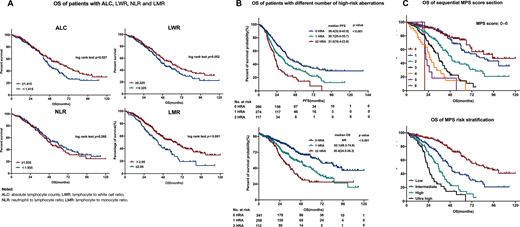Background and Objective: Multiple myeloma (MM) is characterized with significant cytogenetic changes and complex tumor microenvironment, thus patient survival is extremely heterogeneous. Various disease-related or patient-related factors affect the prognosis of patients. This study tried to analyze the prognostic indicators of patients with newly-treated MM, especially explored the prognosis of multiple cytogenetic abnormalities and the ratio of lymphocytes to monocytes (LMR). Additionally, we established a comprehensive prognostic model to help determine the patient prognosis.
Methods: After screening, 603 patients of untreated MM from January 2008 to June 2017, with complete baseline indicators were enrolled into the study. By univariate and multivariate Cox analysis, risk factors related to the prognosis of patients were evaluated, and a weighted prognosis model was established to compare the survival differences of patients in each risk stratification.
Result:
Optimal thresholds of ALC, LWR, NLR and LMR were determined by ROC curve and Youdex index: ALC = 1.415, LWR = 0.325, NLR = 1.935, LMR = 2.95. Survival analysis showed that patients with LMR ≤ 2.95, ALC ≥ 1.415 and LWR ≥ 0.325 had significantly better survival compared with their respective control groups. Cox multivariate analysis showed that among the four indicators, only LMR≤2.95 was an independent adverse prognostic factor for overall survival (OS)(Figure 1A).
17p deletion, 1q21 amplification, t (4; 14) / t (14; 16) were define as high-risk cytogenetic abnormalities (HRA). Of the 603 patients, about 60% were associated with at least one high-risk cytogenetic event. Among them, the occurrence of cumulative 0, 1, 2, and 3 HRA were 39.6% (239/603), 42.5% (256/603), 16.6% (100/603), and 1.3% (8/603), respectively. There was no significant difference in survival among patients with same number of HRAs. The median OS of patients with 0, 1 and ≥ 2 HRA were not reached, 62.1 months (95% CI, 49.3-74.9) and 30.4 months (95% CI, 24.5-36.3), respectively (p <0.001)(Figure 1B).
Final Cox regression model showed that age 65 ~ 74 (HR=1.77, 95%CI, 1.24-2.51, p=0.001), age ≥75 (HR=2.46, 95%CI, 1.69-3.58, p < 0.001), LDH≥247 U/L (HR =1.65, 95%CI, 1.07-2.51, p=0.023), ISS stage III (HR=1.76, 95%CI, 1.24-2.50, p=0.002), LMR≤2.95 (HR=1.53, 95%CI, 1.08-2.18, p=0.017), 1 HRA (HR=1.87, 95%CI, 1.27-2.75, p=0.002) and ≥2 HRA (HR=3.48, 95%CI, 2.22-5.45, p<0.001) are independent adverse prognostic factors for OS. Then weighted risk factors were summed to establish a comprehensive prognosis model, with a total score range of 0-6 points. Accordingly, the whole cohort was divided into low risk (0-1 points, 45.4%), intermediate risk (2 points, 27.9%), high risk (3 points, 19.2%) and ultra-high risk (4-6 points, 7.5 %) groups. The median OS of the four risk groups were 85.8 months (67.1-104.5), 49.0 months (44.7-53.3), 35.4 months (31.3-39.5), and 23.2 months (18.8-27.6), respectively (p<0.001). The C-statistics of this prognostic model is 0.68 (95% CI, 0.64-0.71), which is significantly better than the D-S stage (C-statistics = 0.52, 95% CI, 0.50-0.55, p <0.001), ISS (C-statistics = 0.60, 95% CI, 0.57-0.64, p <0.001) and R-ISS stage (C-statistics = 0.60, 95% CI, 0.57-0.63, p <0.001). Bootstrap resampling and calibration curve showed that the model has an accurate predictive effect on both short-term and long-term prognosis of patients(Figure 1C).
Conclusion:
In our analysis, ALC, LWR, LMR were associated with poor prognosis in NDMM patients, while NLR had no significant prognostic significance. Among the four indicators, LMR≤2.95 was the only independent prognostic factor.
In NDMM patients, survival of patients with the same number of high-risk cytogenetic abnormalities were comparable with each other, regardless of whichever combination of HRA. Higher number of high-risk cytogenetic abnormalities were associated with worse prognosis.
Cox multivariate analysis showed that, old age (65-74 years old, ≥75 years old), increased LDH (≥247 U/L), decreased LMR (≤2.95), ISS III, 1 HRA and ≥ 2 HRA were independent adverse prognostic factors that affect the OS of MM patients.
4. A comprehensive weighted prognostic model was established with the above factors, which was proved to effectively distinguish different prognosis of patients.
No relevant conflicts of interest to declare.
Author notes
Asterisk with author names denotes non-ASH members.


This feature is available to Subscribers Only
Sign In or Create an Account Close Modal